A brief history of computerization in Formula 1
Hi, Giktayms! I present to your attention the translation of the article " A brief history of computing in Formula 1 ".
Today, Formula 1 teams use thousands of ultramodern computers to measure, control, analyze and simulate every aspect of the machines used in the Grand Prix. Software developer team McLaren, Chris Alexander, studied in detail the history of computer technology in sports.
From special on-board electronics to countless virtual servers in data centers around the world, computers have spread in all aspects of Formula 1 engineering. But how did technology come to this? Like the nature of sports, traveling computers in Formula 1 is a story of speed and power.
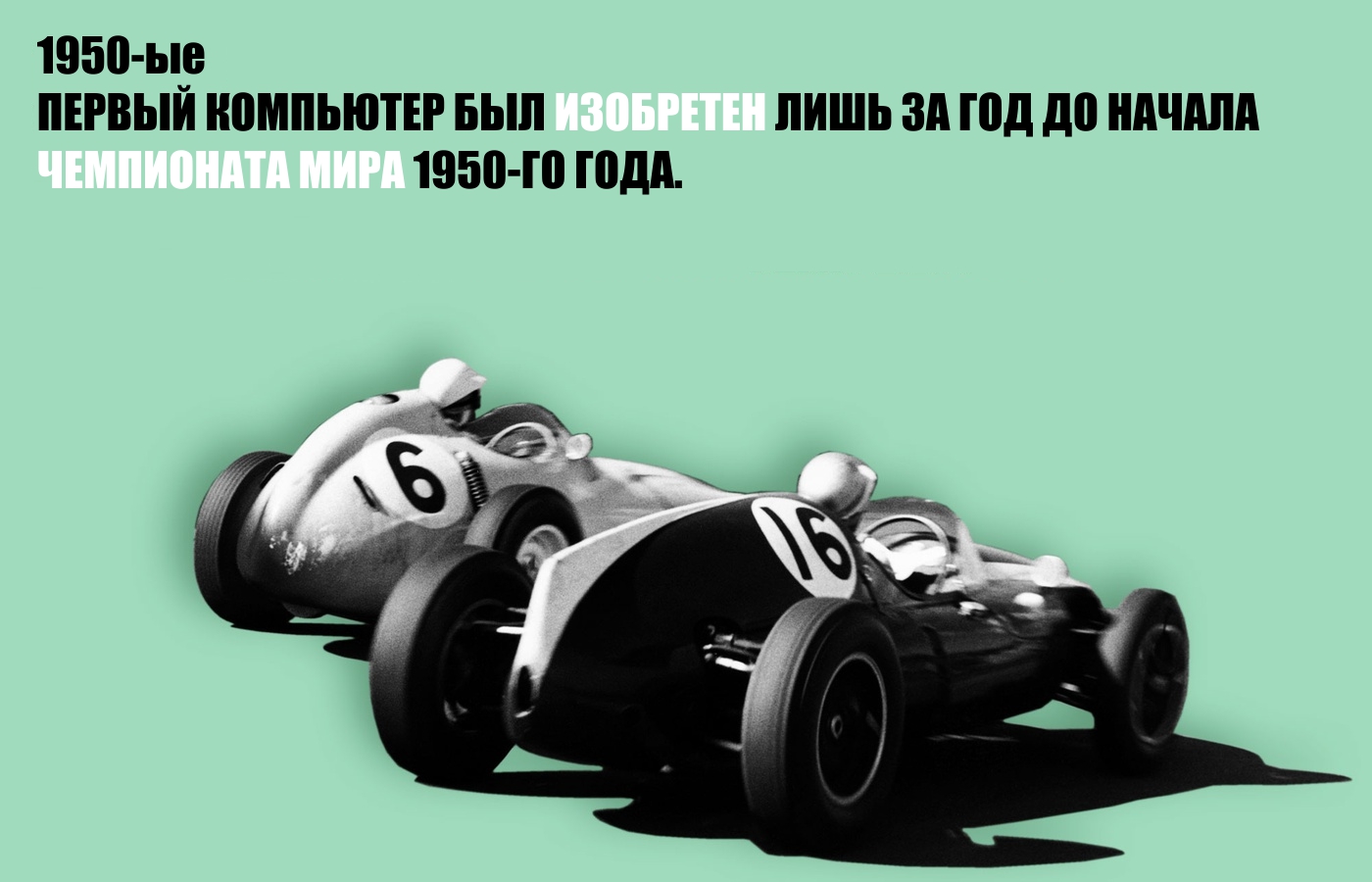
1950s. As you can imagine, the early years of Formula 1 are not greatly influenced by the development of computer technology. In fact, the World Cup started in 1950, and the first computer was invented only a year earlier. The Electronic Delay Storage Automatic Calculator (EDSAC) , as it was called, was built at the University of Cambridge and programmed with five-hole punched tape. Due to the use of primitive technology, he took up as much space as two McLaren MP4-31s cars, and it took him many hours to execute the simplest program!
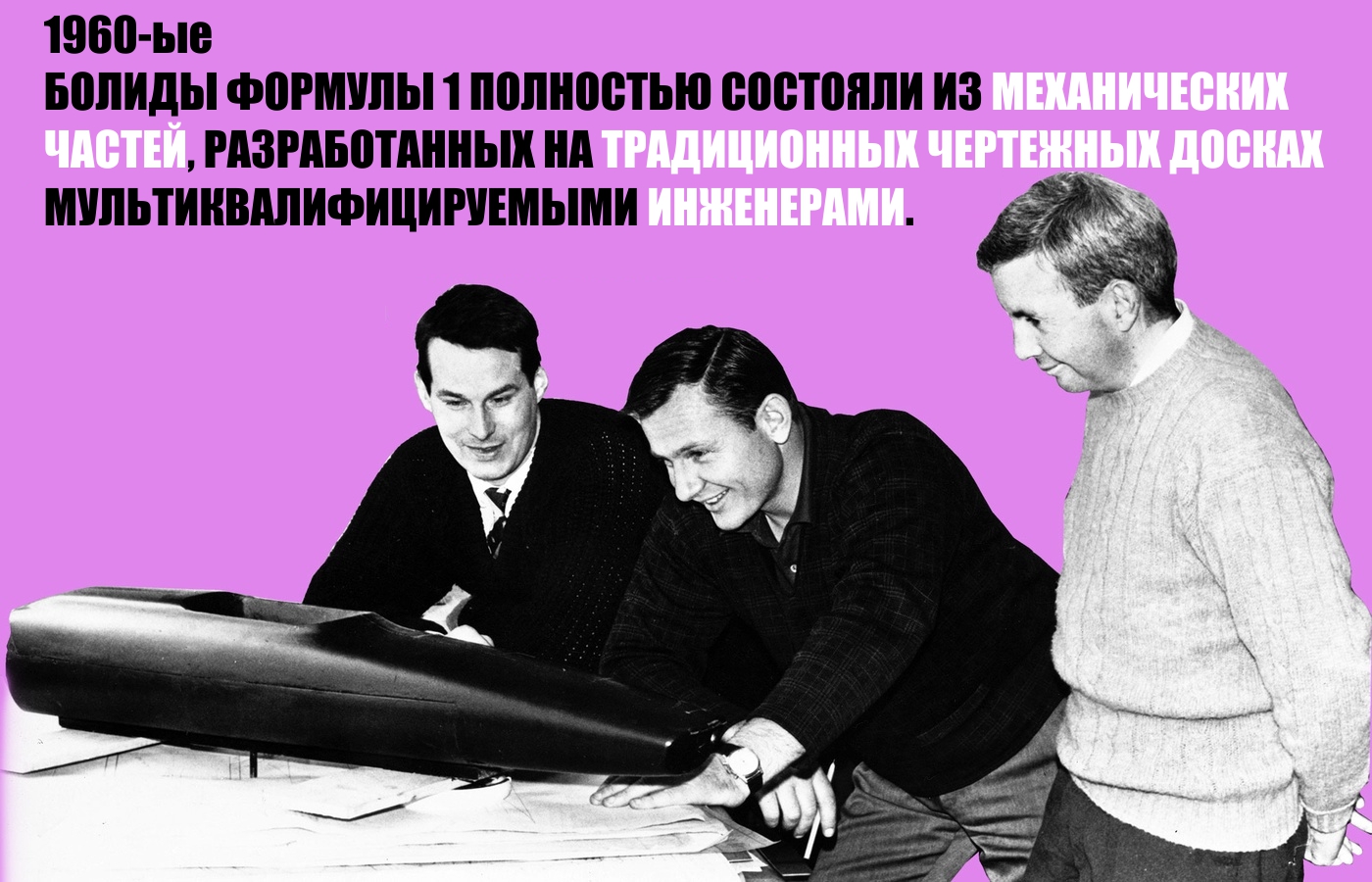
1960s. Formula 1 cars continued to consist only of mechanical devices, designed on traditional drawing boards by general engineers who were armed with mechanical pencils and unusual sets of French rulers.
When Bruce Maclaren and Denny Hulme chased McLaren cars in the late 1960s, the pilot was a key tool in analyzing machine performance. A simple mistake of a rider, or a miscalculation in his understanding of what the car "says" to him, could easily have been the result of getting out of the race.
For example, in 1967 at the Grand Prix of Monaco, Bruce made a pit stop, mistakenly believing that he needed refueling; Jack Brabham pointed to his mistake. Returning to battle, he eventually finished fourth.
In modern cars of Formula 1, thousands of parameters are measured every second, engineers on the track and at the base can analyze the problems of the car, without the need for a pit stop.
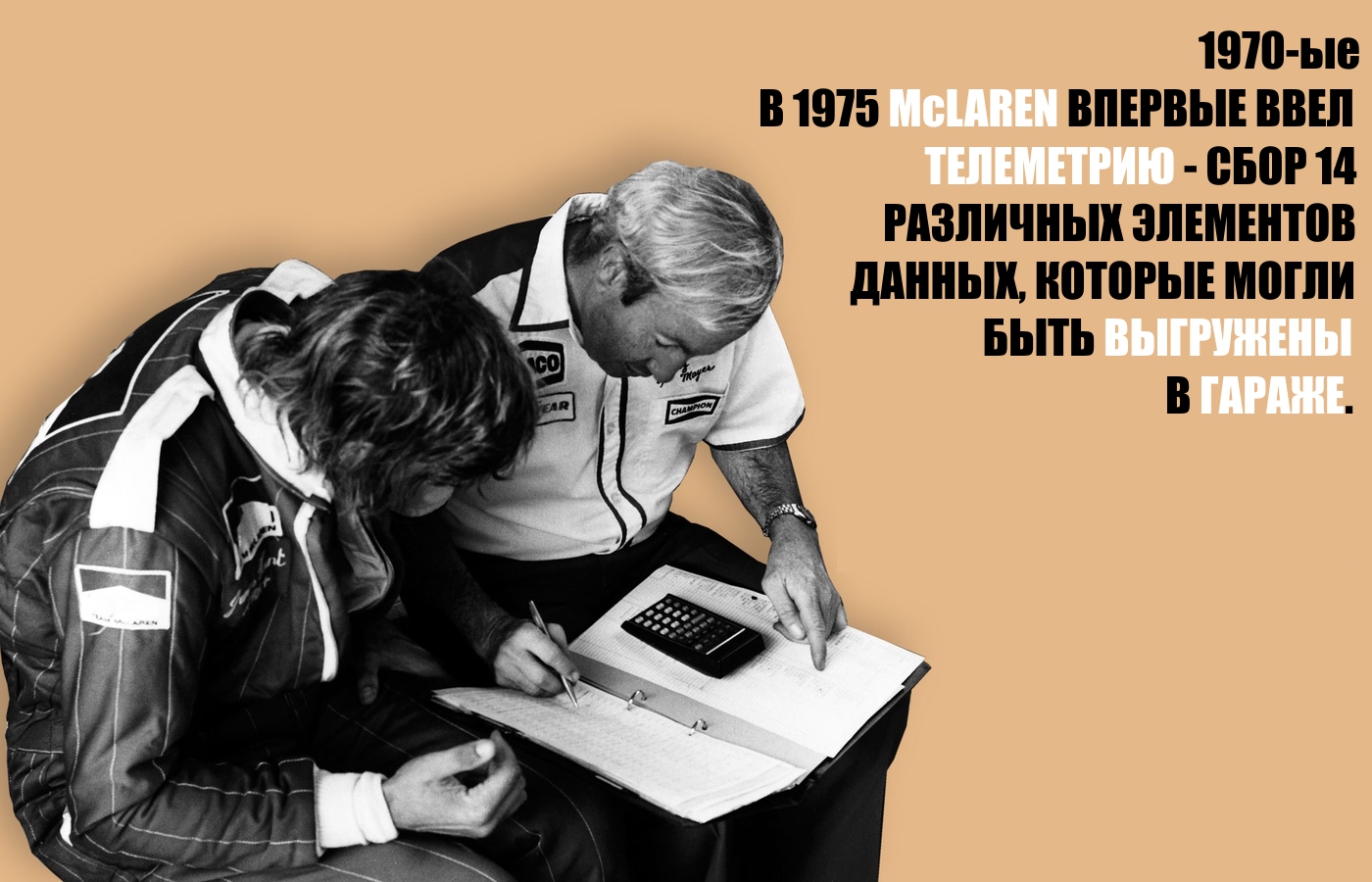
1970s. This was the case until the 1970s, when progress in the development of electronic components and microprocessors contributed to the introduction of what we call today a microcomputer. It happened in 1975, when McLaren first introduced telemetry - collecting data about the car, and it was not in Formula 1, it was the merit of the team in Indikar. 14 different types of data about the car, which could be unloaded in the garage, were collected. For better understanding, this is about the same amount of different types of information that a modern smartphone can take about its environment.
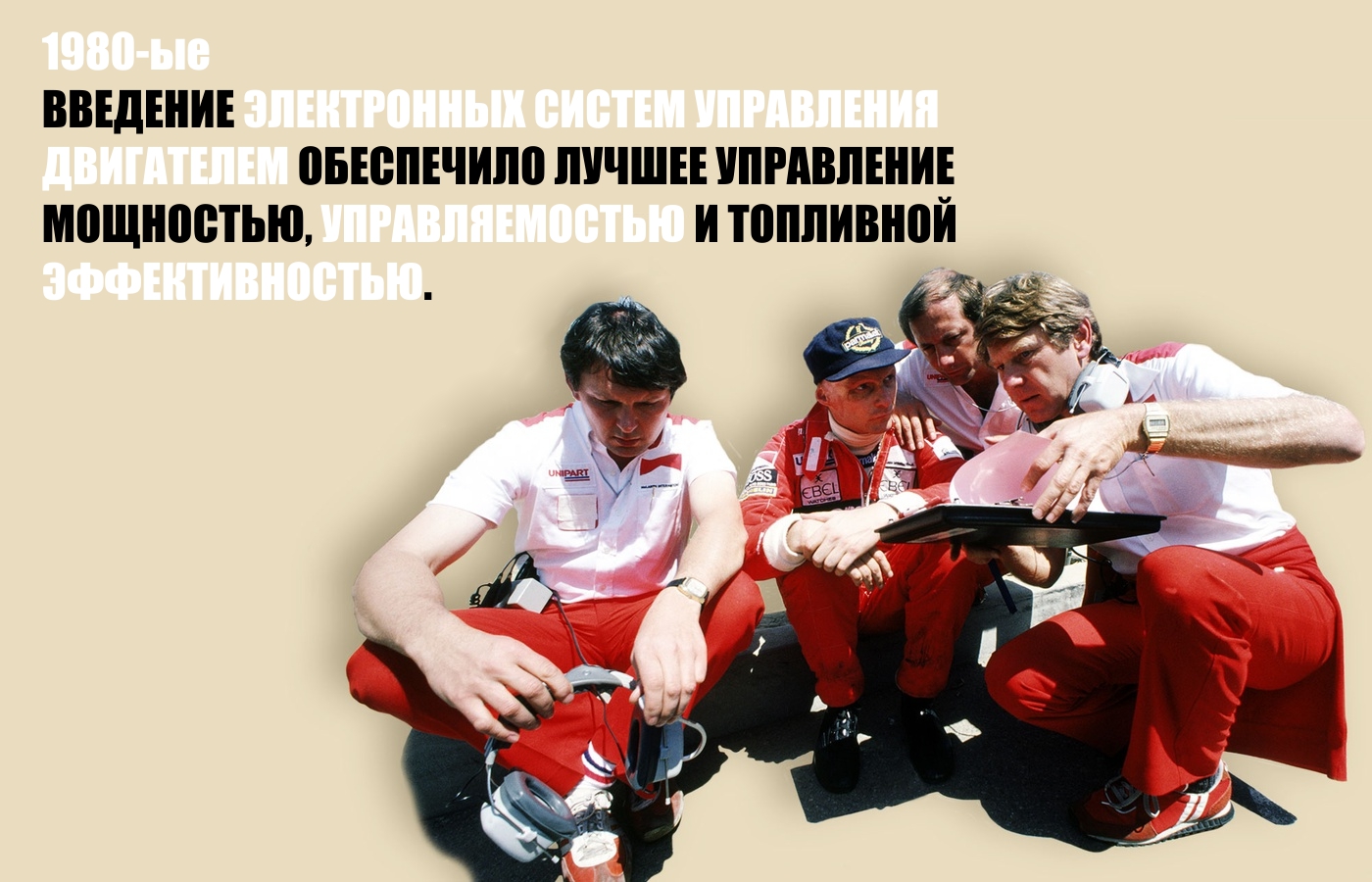
1980s. In the 1980s, along with the boom of home computers, a significant improvement in onboard electronic technology began. Due to the fact that electronic and analog systems have become lighter, smaller and more powerful, the key aspects of any equipment installed on Formula 1 cars have been used by teams, and especially engine manufacturers, to perform more complex systems.
The first electronics was used to perform control tasks, in addition to telemetry, in order to improve the reliability and performance of the car. These control systems are the forerunners of the systems that you can find in your modern machine. They helped to improve the efficiency and reliability of engines, performing diagnostics and tracking races.
In Formula 1, the first types of these electronic systems were only airborne, their lack was the lack of ability to transfer data to the garage. Instead, technicians needed to unload data from the onboard memory only when the car was in the garage. Initially, there was only enough memory for one lap, so the pilot was given an extra signal to turn on telemetry for the selected lap, and the data from the car were taken when they returned to the garage. High rack-mounted computers began to occupy space in garages, alongside conventional mechanical tools.
These were the steps that marked the beginning of the information age in Formula 1.
In the early 1980s, electronic engine management systems also appeared. When McLaren introduced the TAG Turbo engine for an MP4 / 1E car in 1983, it was equipped with an enhanced Bosch system that combined both fuel control and ignition control. This allowed electronics to control power, manageability and fuel efficiency to a much greater degree than was previously possible.
Fuel use was an important issue that needed to be addressed. In 1985, the cars were limited to 220 liters of fuel without refueling; in 1986 this figure was reduced to 195 liters, which meant that careful and efficient use of fuel became extremely important.
The 1985 MP4 / 2B was the first car of the McLaren team, equipped with an electronic fuel reader in the cockpit. Using this technology, Alain Prost was the first to cross the finish line at the San Marino Grand Prix, after Ayrton Senna went down to Lotus and Stefan Johansson to Ferrari, who were ahead, but they ran out of fuel (later Prost was disqualified when his car turned out had a mass below normal).
However, the system remained unreliable. It is known that Prost neglected all warnings and won his second world title in Adelaide in 1986, despite the fact that the fuel indicator was on the red mark. Fortunately for the French indicator was wrong!
It is known that in all the elements of Formula 1, speed is the most important factor, and waiting for uploading actual data from the machine took too much time. In the second half of the 1980s, the first data streams became available in the garage before the car returned to the pitlane.
It was a telemetry “boom” - the car could use radio signals to transmit key data about the passage of each circle in the garage. These small samples of information became available to engineers a few minutes before the car drove into the garage, after which the complete picture of the recorded data became clear.

1990s. Despite the progress that sport received in the first 40 years, it was the 1990s that became the “explosion” of computing abilities - both on the machine and in the whole team.
In 1993, the growth of computerization contributed to the use of technology "active control" of machines. It was the era of using even more electronic control systems than in modern cars: the active suspension increased the stability of the machines; power steering assisted the pilot; brake boosters improved traction at the corners, and the traction control system facilitated the most gentle way out of turns.
It became necessary to collect much more data from the machine, and analyze it with greater frequency than before. This work was assigned to a number of more powerful and high-speed computers. With the growth of onboard technology, the technology of loading and unloading data into the garage began to progress. In turn, computer systems in factories have become larger and faster.
While the regulation of the use of assistive technology in automobiles began, sports contributed to an increase in the use of computers in other areas. It was marked the beginning of the restructuring of the sport.

Nowadays, Formula 1 relies on the use of the Internet to transmit everything - from telemetry to television - around the world, at a rate ten times faster than a normal home connection.
In the 1960s, when electronic systems were just beginning to be used in Formula 1, the Internet was not yet invented; in 1969, ARPANET , the first large-scale network, connected four computers at universities in America. By today's standards, this network was so slow that it would take more than five hours for it to transfer a three-minute music file from one machine to another.
In 2018, you can transfer the same amount of data from the Australian Grand Prix circuit to the McLaren Technology Campus in just a hundredth of a second!
Due to the restriction on the number of personnel allowed to attend events and the amount of equipment that can be transported around the world, now teams of engineers at each base have access to the same data as their colleagues on the track.
Telemetry data is transmitted in real time when the car is on the highway, which gives engineers the opportunity to work together on the analysis of the collected information, as well as share data between the factory and the track. The speed in this process is very important to collect as much useful data as possible for the short but intense workouts that are held before the Grand Prix.
Computers used in modern Formula 1 are undoubtedly among the best.
Ultraportable laptops provide engineers with access to data, modeling and analysis tools that are needed to optimize machine performance for the next event. High-performance workstations enable teams to quickly process complex modulated situations using data from various sources. Special software, such as SAP HANA , allows engineers to process thousands of data rounds by sampling information that can help improve the performance of a race weekend car.
Also, specially designed hardware clusters are groups of ten to hundreds of computers that work together on complex mathematical problems — CFD systems used to improve the aerodynamic component of the car, as well as to use a simulator that allows you to develop the car when the driver is not on the track .
In addition to physical computers, all teams use cloud computing: unlike traditional machines, cloud computers are completely virtual, they work in massive data centers located around the world, and access to them is obtained via the Internet.
When a team of engineers needs to solve a complex problem, or analyze a large amount of data, the cloud can provide thousands of these virtual computers to quickly solve a problem. This technology provides tremendous speed and bandwidth with computing power not comparable with computers in a factory or on a track. In addition, special connections can be organized via the Internet, which allows us to provide high-speed data transfer between the team and cloud servers, as well as first-class protection for sensitive information.
Formula 1 engineers use sophisticated special software that cannot be found on home and office computers.
At McLaren, we have developed our own data analysis and modulation platform, which gives every engineer a team access to system data. This platform combines access to a huge variety of data, from the cars on the Grand Prix track, to the circles covered by our test pilots on the simulator; from aerodynamic data generated in the air tunnel and to specialized equipment tests for individual components of the machine, such as clutches, or brakes.
Due to the fact that all this data can be accessed in the same way, new research and analytical tools can be easily developed for emergency needs that may appear in the rapidly changing Formula 1 environment. This platform also provides a solid foundation for many specialized, high-performance applications. designed for specific engineering disciplines. Virtually every engineering team in a team - from suspension, brakes and chassis, to racing engineers - has its own set of software tools that helps them analyze the most important data for them.
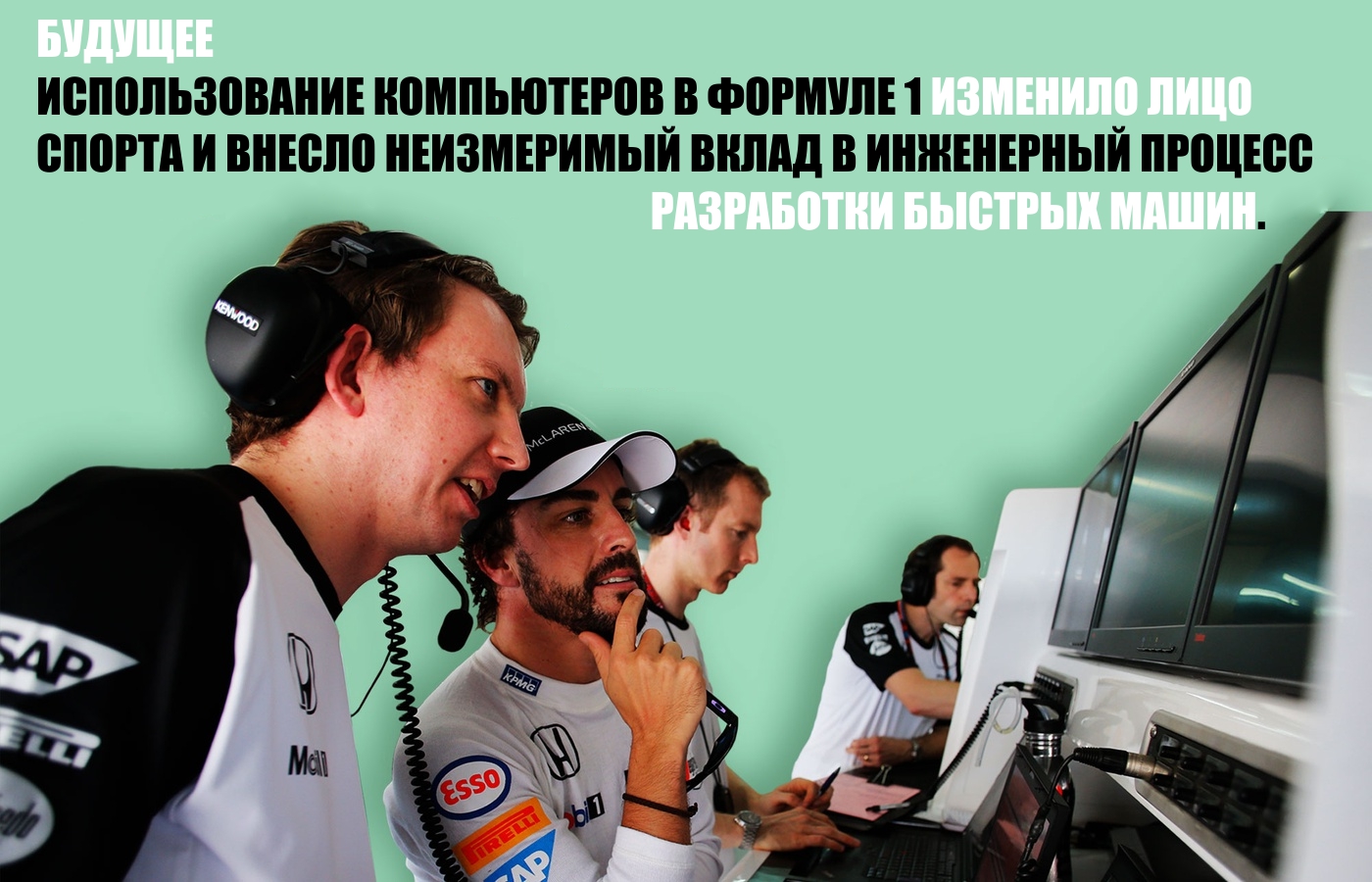
The use of computers in Formula 1 has changed the face of sports and made an immeasurable contribution to the engineering process of developing fast cars. Teams continue to push the boundaries of modulation, development and analysis technologies, and race with properly tuned and optimized machines.
Formula 1, as well as the computer technologies and software used in it, is developing at a tremendous speed in order to meet the constantly changing tasks of design and engineering development.
Today, Formula 1 teams use thousands of ultramodern computers to measure, control, analyze and simulate every aspect of the machines used in the Grand Prix. Software developer team McLaren, Chris Alexander, studied in detail the history of computer technology in sports.
From special on-board electronics to countless virtual servers in data centers around the world, computers have spread in all aspects of Formula 1 engineering. But how did technology come to this? Like the nature of sports, traveling computers in Formula 1 is a story of speed and power.

1950s. As you can imagine, the early years of Formula 1 are not greatly influenced by the development of computer technology. In fact, the World Cup started in 1950, and the first computer was invented only a year earlier. The Electronic Delay Storage Automatic Calculator (EDSAC) , as it was called, was built at the University of Cambridge and programmed with five-hole punched tape. Due to the use of primitive technology, he took up as much space as two McLaren MP4-31s cars, and it took him many hours to execute the simplest program!

1960s. Formula 1 cars continued to consist only of mechanical devices, designed on traditional drawing boards by general engineers who were armed with mechanical pencils and unusual sets of French rulers.
When Bruce Maclaren and Denny Hulme chased McLaren cars in the late 1960s, the pilot was a key tool in analyzing machine performance. A simple mistake of a rider, or a miscalculation in his understanding of what the car "says" to him, could easily have been the result of getting out of the race.
For example, in 1967 at the Grand Prix of Monaco, Bruce made a pit stop, mistakenly believing that he needed refueling; Jack Brabham pointed to his mistake. Returning to battle, he eventually finished fourth.
In modern cars of Formula 1, thousands of parameters are measured every second, engineers on the track and at the base can analyze the problems of the car, without the need for a pit stop.

1970s. This was the case until the 1970s, when progress in the development of electronic components and microprocessors contributed to the introduction of what we call today a microcomputer. It happened in 1975, when McLaren first introduced telemetry - collecting data about the car, and it was not in Formula 1, it was the merit of the team in Indikar. 14 different types of data about the car, which could be unloaded in the garage, were collected. For better understanding, this is about the same amount of different types of information that a modern smartphone can take about its environment.

1980s. In the 1980s, along with the boom of home computers, a significant improvement in onboard electronic technology began. Due to the fact that electronic and analog systems have become lighter, smaller and more powerful, the key aspects of any equipment installed on Formula 1 cars have been used by teams, and especially engine manufacturers, to perform more complex systems.
The first electronics was used to perform control tasks, in addition to telemetry, in order to improve the reliability and performance of the car. These control systems are the forerunners of the systems that you can find in your modern machine. They helped to improve the efficiency and reliability of engines, performing diagnostics and tracking races.
In Formula 1, the first types of these electronic systems were only airborne, their lack was the lack of ability to transfer data to the garage. Instead, technicians needed to unload data from the onboard memory only when the car was in the garage. Initially, there was only enough memory for one lap, so the pilot was given an extra signal to turn on telemetry for the selected lap, and the data from the car were taken when they returned to the garage. High rack-mounted computers began to occupy space in garages, alongside conventional mechanical tools.
These were the steps that marked the beginning of the information age in Formula 1.
In the early 1980s, electronic engine management systems also appeared. When McLaren introduced the TAG Turbo engine for an MP4 / 1E car in 1983, it was equipped with an enhanced Bosch system that combined both fuel control and ignition control. This allowed electronics to control power, manageability and fuel efficiency to a much greater degree than was previously possible.
Fuel use was an important issue that needed to be addressed. In 1985, the cars were limited to 220 liters of fuel without refueling; in 1986 this figure was reduced to 195 liters, which meant that careful and efficient use of fuel became extremely important.
The 1985 MP4 / 2B was the first car of the McLaren team, equipped with an electronic fuel reader in the cockpit. Using this technology, Alain Prost was the first to cross the finish line at the San Marino Grand Prix, after Ayrton Senna went down to Lotus and Stefan Johansson to Ferrari, who were ahead, but they ran out of fuel (later Prost was disqualified when his car turned out had a mass below normal).
However, the system remained unreliable. It is known that Prost neglected all warnings and won his second world title in Adelaide in 1986, despite the fact that the fuel indicator was on the red mark. Fortunately for the French indicator was wrong!
It is known that in all the elements of Formula 1, speed is the most important factor, and waiting for uploading actual data from the machine took too much time. In the second half of the 1980s, the first data streams became available in the garage before the car returned to the pitlane.
It was a telemetry “boom” - the car could use radio signals to transmit key data about the passage of each circle in the garage. These small samples of information became available to engineers a few minutes before the car drove into the garage, after which the complete picture of the recorded data became clear.

1990s. Despite the progress that sport received in the first 40 years, it was the 1990s that became the “explosion” of computing abilities - both on the machine and in the whole team.
In 1993, the growth of computerization contributed to the use of technology "active control" of machines. It was the era of using even more electronic control systems than in modern cars: the active suspension increased the stability of the machines; power steering assisted the pilot; brake boosters improved traction at the corners, and the traction control system facilitated the most gentle way out of turns.
It became necessary to collect much more data from the machine, and analyze it with greater frequency than before. This work was assigned to a number of more powerful and high-speed computers. With the growth of onboard technology, the technology of loading and unloading data into the garage began to progress. In turn, computer systems in factories have become larger and faster.
While the regulation of the use of assistive technology in automobiles began, sports contributed to an increase in the use of computers in other areas. It was marked the beginning of the restructuring of the sport.

Nowadays, Formula 1 relies on the use of the Internet to transmit everything - from telemetry to television - around the world, at a rate ten times faster than a normal home connection.
In the 1960s, when electronic systems were just beginning to be used in Formula 1, the Internet was not yet invented; in 1969, ARPANET , the first large-scale network, connected four computers at universities in America. By today's standards, this network was so slow that it would take more than five hours for it to transfer a three-minute music file from one machine to another.
In 2018, you can transfer the same amount of data from the Australian Grand Prix circuit to the McLaren Technology Campus in just a hundredth of a second!
Due to the restriction on the number of personnel allowed to attend events and the amount of equipment that can be transported around the world, now teams of engineers at each base have access to the same data as their colleagues on the track.
Telemetry data is transmitted in real time when the car is on the highway, which gives engineers the opportunity to work together on the analysis of the collected information, as well as share data between the factory and the track. The speed in this process is very important to collect as much useful data as possible for the short but intense workouts that are held before the Grand Prix.
Computers used in modern Formula 1 are undoubtedly among the best.
Ultraportable laptops provide engineers with access to data, modeling and analysis tools that are needed to optimize machine performance for the next event. High-performance workstations enable teams to quickly process complex modulated situations using data from various sources. Special software, such as SAP HANA , allows engineers to process thousands of data rounds by sampling information that can help improve the performance of a race weekend car.
Also, specially designed hardware clusters are groups of ten to hundreds of computers that work together on complex mathematical problems — CFD systems used to improve the aerodynamic component of the car, as well as to use a simulator that allows you to develop the car when the driver is not on the track .
In addition to physical computers, all teams use cloud computing: unlike traditional machines, cloud computers are completely virtual, they work in massive data centers located around the world, and access to them is obtained via the Internet.
When a team of engineers needs to solve a complex problem, or analyze a large amount of data, the cloud can provide thousands of these virtual computers to quickly solve a problem. This technology provides tremendous speed and bandwidth with computing power not comparable with computers in a factory or on a track. In addition, special connections can be organized via the Internet, which allows us to provide high-speed data transfer between the team and cloud servers, as well as first-class protection for sensitive information.
Formula 1 engineers use sophisticated special software that cannot be found on home and office computers.
At McLaren, we have developed our own data analysis and modulation platform, which gives every engineer a team access to system data. This platform combines access to a huge variety of data, from the cars on the Grand Prix track, to the circles covered by our test pilots on the simulator; from aerodynamic data generated in the air tunnel and to specialized equipment tests for individual components of the machine, such as clutches, or brakes.
Due to the fact that all this data can be accessed in the same way, new research and analytical tools can be easily developed for emergency needs that may appear in the rapidly changing Formula 1 environment. This platform also provides a solid foundation for many specialized, high-performance applications. designed for specific engineering disciplines. Virtually every engineering team in a team - from suspension, brakes and chassis, to racing engineers - has its own set of software tools that helps them analyze the most important data for them.

The use of computers in Formula 1 has changed the face of sports and made an immeasurable contribution to the engineering process of developing fast cars. Teams continue to push the boundaries of modulation, development and analysis technologies, and race with properly tuned and optimized machines.
Formula 1, as well as the computer technologies and software used in it, is developing at a tremendous speed in order to meet the constantly changing tasks of design and engineering development.
All Articles